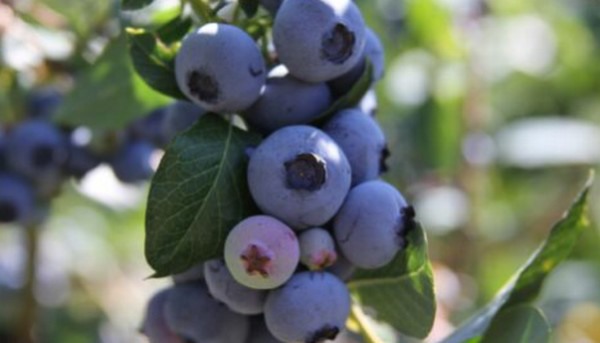What’s ahead for 2023 blueberry production? Joseph Vargas, director of business intelligence at the North American Blueberry Council (NABC), shares a 2023 crop outlook report.
Peru: For 2022, Peru had 339 million lbs. coming into the U.S. and 644 million lbs. total. “That’s looking to increase for the 2023-24 season to 373.5 million lbs. U.S. for a total forecast of 747 million lbs. of production in Peru,” says Vargas. “The import into the U.S. is steadily growing and we’re starting to see less dramatic peaks and valleys as global production efforts continue to strive for more steady year-round supply.”
He also notes that last year, Peru exceeded 50 percent of total U.S. blueberry imports and that number is expected to continue to grow.
Chile: “Overall, Chilean blueberry supply to the U.S. has stayed pretty flat,” says Vargas. The overall global production has had a bit of an increase year over year. Last year was 175 million lbs. of which 47 million lbs. was processed versus 363 million lbs. total for Chile globally, with 115 lbs. processed and 248 lbs. actual. “We’re seeing a bit of an uptick in processed berries from Chile. It’s anticipated the processed might be less than last year for 2023-2024,” says Vargas.
Chile’s supply has become a notably smaller percentage of the overall U.S. imports–in 2011, it accounted for 67 percent of total imports, and in 2022, that number had dropped to 19 percent.

Mexico: Last year, Mexico overall was 172.9 million lbs., with most of its production coming to the U.S.–over 95 percent. “182 million lbs. is forecast for 2023. The rate of growth appears to be tapering, but steady growth of production and imports into the U.S. is anticipated to continue.”
British Columbia
Highbush: Last year, 104 million lbs. of highbush were imported into the U.S. from B.C., with 62.4 million lbs. of that production coming in as processed and 41 million lbs. in fresh. “All of the Northwest did have a smaller window to bring fruit in due to weather-related delays. The result was missing some front-end sales that are normally anticipated. This season we should see more of a normal spring. A few tough Northwest growing seasons have contributed to a slight decline year over year in the last few seasons,” says Vargas. The U.S. import forecast for Canada is 126 million lbs.
Lowbush/wild:This includes Canada and the Northeast U.S. “Last year, we saw 341 million lbs. coming out for lowbush and for this season it’s 310 million, so a slight decline over last year,” says Vargas.
Florida: Last year, the state did 25.1 million lbs. and virtually all of that was fresh. “This season it anticipates somewhere between 22.5-24 million lbs. There are a lot of variables out there and they’re right in the middle of harvest,” says Vargas.
Mississippi: “It's had some bad weather and I anticipate the forecast actually coming down quite a bit,” says Vargas. Last year, the state did about 2 million lbs. but had projected about 2.5 million lbs. To date, there’s no firm number, but it’s understood that Mississippi has lost a lot of commercial production.
California: The state is starting to harvest and anticipates 80 million lbs. for this next season – 55 million lbs. of that fresh and 25 million lbs. processed. “Last season, California produced 51 million lbs. fresh and 12 million processed, for 63.6 million total. So far this year, the whole West Coast has had a lot of rain and cooler temperatures, which may have an impact.”
Georgia: Last year, Georgia had 54 million lbs. total–38 million was fresh and 16 million was processed. “We have heard Georgia could have a very good year this year the way the weather has cooperated so far. It is early,” says Vargas. “It could have an uptick for the 2023 season and anticipates 85 million total lbs.–25 million lbs. processed and 60 million lbs. fresh.”
North Carolina: Also with good weather, the state estimate is for 40-45 million lbs. Last year, it was at 36.5 million lbs. “The last five to seven production years have been lower than the state’s all-time high in 2015 of almost 50 million pounds. However with favorable weather, it is anticipated that this year could be closer to 2015,” says Vargas.
New Jersey: Its production stayed consistent over the last seven to eight years. “It’s around 34 million lbs. this last year–4 million lbs. was processed. Its forecast for 2023 is 40 million lbs., with 36 million lbs. in fresh product and 4 million lbs. in processed.”
Indiana: Last season was about 3.3 million lbs. and next season is anticipated to be 3.2-3.3 million lbs.
Michigan: “There are a lot of new plantings going on and taking out the older varieties and putting in the newer ones, which is being echoed across the U.S., according to growers,” says Vargas. Last year, it was at 30 million lbs. fresh and 26 million processed, for a total of 56 million lbs. The 2023 forecast is 40 million lbs. fresh, with 28 million processed, for a total of 68 million.
Oregon: The state is still seeing snow, rain and cooler temperatures in some areas. Last year, it had 157 million lbs., with 63 million lbs. fresh and 94 million lbs. processed. “This season it is anticipated to be at 175 million lbs.–96 million lbs. processed and 79 million lbs. fresh,” says Vargas. “In Oregon and Washington, similar to California, we’ve been seeing incremental increases in overall production and some of that is coming in as efficiencies – you’re getting up in fresh and processed, but the processed is really coming along higher than the others.”
Washington: Again, it is seeing cooler temps so far on the western side of the state. According to the Washington Blueberry Commission, there are more plantings going into Washington than in any other state, which will contribute to season-over-season growth.
Last year was 51 million lbs. fresh and 124 million lbs. processed, for 175 million lbs. total. For 2023, it’s anticipated the crop will be about 59 million lbs. fresh and 126 million lbs. processed, for a total of 185 million, which is up slightly from the prior year.
 For more information:
For more information:
Amanda Griffin
North American Blueberry Council
Tel: +1 (916) 333-7863
[email protected]
https://nabc.blueberry.org/
